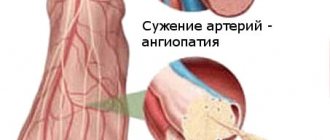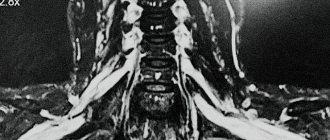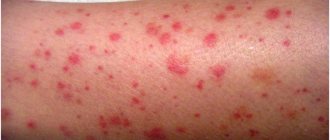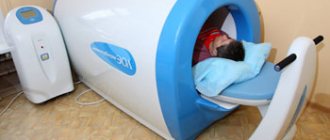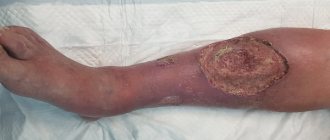Blue or blackening of gangrenous areas is associated with the active synthesis of iron sulfide produced during the destruction of hemoglobin. Gangrene affects any tissue and organs - the skin, subcutaneous fat, muscle structures, smooth muscles of internal organs.
Gangrene of the limbs is an irreversible process, the spread of which can only be stopped through surgical intervention (vascular shunting). Such manipulations make it possible to avoid complete amputation of a limb, limiting itself only to the removal of necrotic (dead) tissue.
For dry gangrene
the boundary between dead black skin and living skin of normal color is clearly defined (line of demarcation). Dry gangrene is more favorable than wet gangrene. This is due to the fact that dead tissue is well separated from living tissue and practically no decay products enter the bloodstream, causing intoxication. Dry gangrene usually develops against the background of prolonged ischemia, when collateral small vessels have time to form, feeding damaged tissues, and as ischemia worsens, the body “manages” to limit the necrotic process.
What is gangrene
Gangrene is the process of tissue death of body parts or organs with a color change in the area of death from blue to black. The darkening of the tissue is caused by the presence of iron sulfide, which is formed when hemoglobin in the blood is destroyed. This disease can affect not only the limbs, but also the lungs, intestines or gall bladder.
Based on the type of dead tissue, gangrene is divided into dry and wet.
With dry gangrene, which most often affects the extremities, the blood vessels become clogged slowly. This process takes months or even years. The body's protective reaction allows it to independently isolate healthy tissue from damaged tissue (usually the fingers or feet are affected first). The dead tissue dries out, while practically no decay occurs, there is no smell or intoxication of the body. If dry gangrene does not turn into wet gangrene, then there is no direct threat to the patient’s life, but there is a danger of complications. To avoid complications, as well as for cosmetic purposes, blackened necrotic tissue is amputated.
Wet gangrene develops acutely, as a result of rapid blockage of blood vessels, while infection is always present. The root cause of the disease is frostbite, injury, burn or acute arterial insufficiency. The affected tissue is enlarged in volume and filled with hydrogen sulfide, has a corpse-like appearance and smell, and color ranges from greenish to purple. To save the life of an elderly person, surgical removal of the diseased organ is performed. Both limbs and internal organs can be affected.
Symptoms of gangrene
Typically, gangrene is preceded by prolonged pain in the distal (most distant) parts of the limb - fingers, heel. This is observed with gradual blockage of blood vessels, for example, with obliterating atherosclerosis. In acute arterial thrombosis, pain occurs suddenly, and if left untreated, gangrene begins to form within a few hours (days).
Gangrene begins with the appearance of a bluish spot on the skin of the toes or heel, which gradually increases in size, turns from bluish to dark, then turns black. If gangrene is dry , then it manifests itself as a black area of skin (or a finger, sometimes part of the foot with fingers) with a clear demarcation from intact tissue. The patient's general condition usually does not suffer, the temperature and health are normal. The severity of the pain syndrome varies. Wet gangrene manifests itself as blackening of the skin of a finger or several fingers and part of the foot without demarcation, i.e. next to the black areas of the skin there are purple-bluish ones, higher up there is redness and swelling. There is no clear boundary between areas of different colors. The general condition can be severe (not always), body temperature usually rises. Wet gangrene tends to spread to the upper parts of the limb.
Surgical method
Surgery is necessary for wet gangrene because it is the only way to save the patient’s life. During surgery, the surgeon removes the infected tissue and all tissue located near the affected area. When using the surgical method, the following operations are also performed:
- blood transfusion;
- detoxification therapy (use of antibiotics).
Surgical intervention for gangrene of the legs involves amputation of the limb
Along with the treatment of gangrene, actions can be taken to eliminate other complications:
- microsurgical bypass surgery, which makes it possible to save the foot if gangrene of the toe is diagnosed;
- treatment of ischemia, aimed at reducing pain during the development of wet gangrene;
- stenting allows you to reduce the severity of surgery, and sometimes avoid amputation;
- removal of blood clots using a probe.
Wear only comfortable shoes to avoid the appearance of blisters
Treatment of gangrene
The main treatment method is amputation. Those tissues that are dead cannot be brought back to life, so they must be removed. The question is usually about the level of amputation. The approach here is ambiguous. It would seem that if one finger is affected by gangrene, why not limit it to amputation? But if all the arteries of the leg, the popliteal artery, are affected, then after amputation of the finger the wound will not heal, the sutures will “fall apart”, the necrotic process will progress further, which will require a higher amputation already at the level of the foot. Then the wound does not heal again - amputation at the level of the lower leg, then at the level of the thigh, where the wound almost always heals, because In the thigh, blood circulation is usually good, which is associated with the flow of blood from the deep femoral artery and from the internal iliac artery. Each operation is stressful for the body and increases the danger to life. Therefore, amputation must be done once and at a level that ensures good wound healing.
“Minor” amputations (fingers, part of the foot) can be limited to diabetic gangrene, because general blood circulation in the limb is usually preserved (if diabetes is not combined with atherosclerosis of the arteries). With obliterating atherosclerosis, amputations usually have to be done “high”, at the level of the hip. In some cases, it is possible to perform reconstructive surgery on blood vessels (bypass surgery, stenting) - then blood circulation in the limb improves, which makes “low” (at the level of a finger, foot) amputation possible.
Patients also receive therapy aimed at improving microcirculation in the limb (angioprotectors, antiplatelet agents), antibacterial therapy, and pain relief.
Diabetic foot syndrome: what you need to know?
Prevention of DFS - foot care
Despite the preventive measures that are reported to patients with diabetes by their attending physicians, diabetic foot syndrome continues to increase its sad statistics.
According to Dr. Udovichenko, this is due to two points. Firstly, patients rarely adhere to their doctor’s recommendations one hundred percent. Secondly, it is necessary to take into account the characteristics of patients with diabetes mellitus, who, due to reduced nervous sensitivity, visual impairment (due to age or diabetes), and excess weight, are unable to recognize injuries on their legs in a timely manner. They often perceive their lower limbs as “wooden”, and when they injure their leg, they do not realize that they actually injured it.
A separate risk category is formed by elderly patients who are not able to fully care for their feet (cut nails, treat calluses), thereby creating conditions for the occurrence of foci of suppuration.
“In those countries where podiatric care is well provided and patients undergo preventive foot treatment (pedicure, callus removal) at least once a month, the risk of developing DFS is much lower. But in our country such measures are not yet available"
, says Oleg Udovichenko.
The need for regular preventive treatment is reduced by wearing preventive shoes, which reduce the local load and the rate of callus formation, under which a focus of suppuration most often forms.
Reducing the risk of DFS: drug therapy with proven effectiveness
One of the main factors leading to diabetic foot syndrome is atherosclerosis of the arteries of the lower extremities. However, in Russian realities, the fight against it is carried out using rather original methods. In domestic medicine, there is still a widespread myth that periodic drip administration of vascular drugs has a beneficial effect on the condition of the arteries of patients with diabetes and fights atherosclerosis, although large-scale clinical studies conducted abroad have proven the opposite: such drugs do not have any protective effect render.
“The popularity of this approach in Russia can be associated with the fact that this myth fits perfectly with the patient’s ideas about ideal therapy: when medications can be taken in courses, with treatment from time to time. Significant material resources and the labor of medical staff are wasted, and the patient is given the illusion of health, although he continues to walk with high levels of cholesterol and blood sugar. When we tell our patients that drugs with proven effectiveness against atherosclerosis require daily use for many years, we evoke a number of negative emotions on their part.”
, states Oleg Udovichenko.
According to Dr. Udovichenko, one should not place much hope on neurotropic drugs (in particular, thioctic acid), which appeared at the disposal of doctors about 20 years ago and are considered pathogenetic (that is, not just eliminating symptoms) for the treatment of diabetic neuropathy. According to recent studies, they have rather low clinical effectiveness in relation to the causes of diabetic neuropathy, having a proven effect only on its symptoms.
Today, it is possible to inhibit the development of diabetic neuropathy and peripheral atherosclerosis in only two ways, recognized throughout the world. Firstly, due to the normalization of carbohydrate metabolism, i.e. bringing blood sugar levels closer to normal. Secondly, through an aggressive fight against risk factors for cardiovascular diseases (lowering cholesterol and especially low-density lipoproteins, blood pressure, weight loss, quitting smoking), which will slow down the development of atherosclerosis and ischemia (blood supply disorders) of the extremities.
Action plan for foot ulcers
The most important point in the treatment of a patient with diabetic foot syndrome is a referral to a specialized clinic or office where they treat diabetic foot. Today, this approach is considered the most effective, since only specialists from this office/clinic can implement a full range of measures for the treatment of SDS.
“In the UK, GPs are prohibited from treating diabetic patients who have developed peptic ulcers. The decision was made at the level of the Ministry of Health in 2014. According to experts, this will help to significantly reduce the rate of amputations and improve the quality of life of such patients."
, says Dr. Udovichenko.
During the patient’s first visit to the diabetic foot office, the doctor diagnoses which form of DFS the patient has and, depending on it, prescribes treatment.
For example, the neuropathic form (with preserved blood flow), which accounts for more than half of the cases, requires the implementation of the following measures:
- Unloading the diabetic defect area by constantly wearing unloading devices.
- Proper local treatment of the wound using modern dressings that have replaced the gauze bandage.
- Correction of diabetes treatment, achieving target blood sugar levels.
- If necessary, eliminate wound infection using systemic antibiotic therapy. Topical antimicrobials (povidone iodine, topical antibiotics, and even silver-based drugs) have no proven effect in either preventing or treating wound infections.
For the neuroischemic form of diabetic foot syndrome (against the background of reduced blood flow), a similar approach is used, which is complemented by the use of drugs for pain relief and revascularization methods (restoration of blood flow).
There are also options for DFS in which conventional outpatient treatment (with visits to the Diabetic Foot office every 1-2 weeks) will not be effective. In such cases, hospitalization is required - for intravenous antibiotics or surgical intervention on the foot in the presence of deep purulent foci.
To restore arterial blood flow, hospitalization is also required, but it can be short-term - within 4-5 days.
Prevention of gangrene in private nursing homes “Longevity”
In the Longevity boarding houses, elderly guests are provided with comprehensive services, including regular examinations by doctors, as well as a set of preventive measures to prevent the development of this serious illness. At the initial stage, the disease can be prevented or the process of necrosis can be stopped in time. Experienced boarding house specialists know how gangrene begins in the elderly, what it looks like, so they can easily detect not only the beginning of gangrene, but also its precursors by the symptoms.
In addition, our guests are provided with:
- full care and supervision for the elderly and sick 24 hours/7 days a week (for bedridden patients - special medical beds with anti-decubitus mattresses);
- 5-6 balanced meals a day (dietary meals are prescribed if necessary);
- comfort in the rooms, choice of accommodation (1, 2, 3-bed rooms);
- individual psychological assistance, organized leisure, walks, interest groups.
The boarding houses are located in quiet and cozy places in Moscow and the Moscow region (in Ramenskoye, Vidnoye, Zelenograd, Belozerki). All houses have their own fenced area with picturesque nature.
Our guests, no matter how severe their illnesses, do not feel lonely and abandoned. Here they always feel support, help and confidence in the future.
Stages of pathology development
Regardless of the form of the disease, it develops sequentially. When moving to a new stage, existing symptoms become more acute and new ones are added.
The course of diabetic foot, regardless of classification, is as follows:
- Initial stage. It is characterized by changes in the shape of the foot, bone deformation, and the formation of blisters and calluses.
- Stage 1. Accompanied by the formation of ulcers and necrotic wounds, while the deep structures of the skin are not damaged.
- Stage 2. Ulcerative and necrotic skin lesions deepen into the dermis, affecting muscles, joints, and tendons.
- Stage 3. The ulcer deepens to the bone tissue, and in the vast majority of cases a wound infection is associated. An abscess and osteomyelitis develop.
- Stage 4. It is characterized by the formation of limited gangrene on the supporting part of the foot. The tips of the fingers turn black, the destructive process has smooth and clear edges. At this stage, the limb can still be saved through surgery.
- Stage 5. Accompanied by a significant increase in the area of tissue death. Gangrene affects the lower leg. In this situation, the process is irreversible, and the only option to save the patient’s life is amputation.
Diagnostics
Diagnosis of diabetic foot involves examination by an endocrinologist and neurologist. At the appointment, the specialist performs a sensitivity analysis of the foot and listens to the blood flow in the arteries of the foot. In order to make a diagnosis, it is necessary to undergo a comprehensive examination, including:
- X-ray examination aimed at assessing the condition of the bones in the affected area;
- a blood test, based on the results of which a specialist will determine the severity of the inflammatory process;
- Dopplerography and ultrasound to assess the condition of the vascular bed in the affected area;
- X-ray contrast angiography of blood vessels, with which the doctor will assess the general state of blood flow in the affected limb.
Diagnosis of diabetic foot syndrome is a key point in selecting the correct treatment tactics. The sooner you consult a doctor, the higher the likelihood of avoiding surgical intervention and limiting yourself to conservative methods of therapy.
Effect of diabetes on feet
If blood glucose levels are consistently high for 5-10 years, metabolism is disrupted. This leads to the formation of trophic changes in the bones, skin, muscles, blood vessels, and tendons. The legs suffer first - diabetes is often accompanied by excess weight and varicose veins.
Also, patients with diabetes have reduced immunity, as a result of which wounds, scratches, and ulcers take months to heal. The pathology is accompanied by a violation of the nerve conduction of the skin, as a result of which a person simply does not feel damage to the skin. All this leads to the development of diabetic foot. Untimely treatment can lead to serious complications, leading to serious consequences: from amputation to death.
